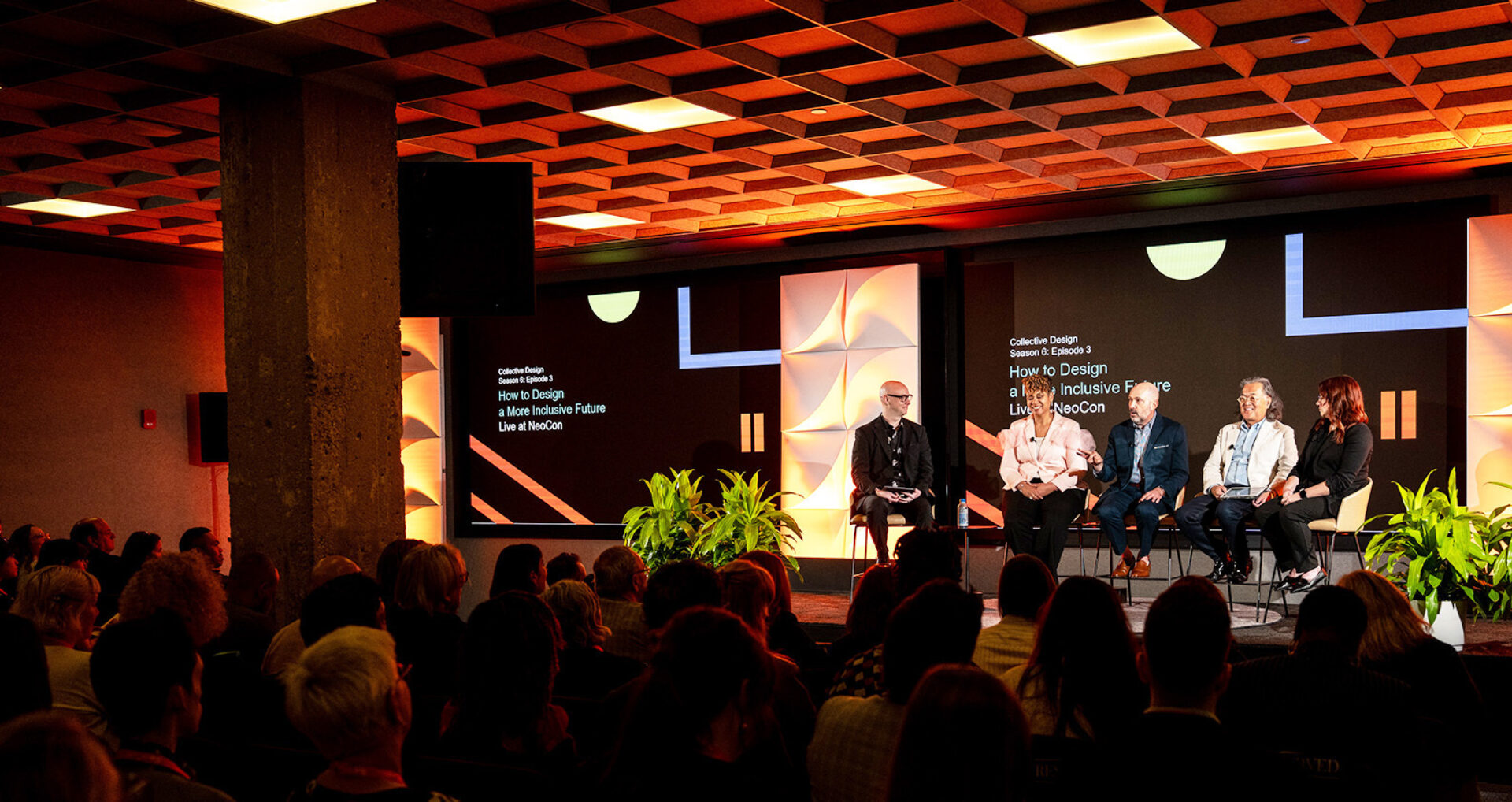What does inclusion really look like in the built environment — not just in principle, but in practice? IIDA’s Collective Design — live at NeoCon 2025 —explored that question head-on, bringing together four leading voices in design for a deeply human conversation about the future of public space.
Moderated by IIDA’s Futurist-in-Residence Mark Bryan, IIDA, the panel featured Tom Polucci, FIIDA, AIA (Firmwide Director of Interiors, HOK), Jessica Bantom, Assoc. IIDA (Global Leader of Equity, Diversity, and Belonging, DLR Group), Joey Shimoda, FIIDA, FAIA (Co-Founder, Shimoda Design Group), and Erin Jennings, IIDA, AIA (Principal, Luminaut) — each offering a unique lens on how we can build environments that truly welcome everyone.
But first, a reality check: more than 334 million people live in the U.S., and a new person is born every nine seconds. Our communities are constantly evolving — so our spaces must evolve too. “Design is more than aesthetics,” Bryan reminded the audience. “It shapes connectivity, future experiences, and future perceptions.”
Listening as a Design Strategy
“Inclusive spaces are where you feel comfort and safety — where you can just be,” said Polucci. That emotional baseline, he explained, is what allows people to thrive — and it can’t be assumed. Bantom expanded on that idea, challenging the room to consider how personal experience can distort our understanding of inclusivity. “What’s inclusive for me might not be inclusive for someone else,” she said. “The real test is the experience of the people using the space.”
It was a theme that carried through the session: inclusion starts not with answers, but with questions. For Bantom, that means slowing down, checking assumptions, and making space for voices that are too often overlooked. “We need to stop and acknowledge the perspectives we’ve ignored,” she added. “That’s what makes space for innovation.”
Takeaway: Before you design for someone, listen to them. Inclusion isn’t a fixed standard — it’s a dialogue.

Designers as Stewards
At the heart of the conversation was a powerful reminder: design is not just about creating spaces — it’s about serving people. “We came into design because we wanted to make a better world,” said Bantom. “Designers are servers. That’s what we signed up for.” That sense of responsibility was echoed by Jennings, whose work in schools and libraries centers the needs of growing minds and communities. “It’s about design responsibility,” she said. “When it comes to learning environments, we have to design with the brilliant minds of the next generation — not for them.”
The panelists pushed for a participatory mindset — a practice of design grounded in humility, curiosity, and co-creation. “Design intuitively,” said Shimoda. “Ask questions. Involve people in the conversation.”
Takeaway: Good design doesn’t speak for people — it speaks with them.
Designing for the Senses — and for Everyone
True inclusion doesn’t stop at ramps or signage. It lives in the textures, sounds, smells, and rhythms of a space — in the way it makes us feel, focus, or belong. For Polucci, that means designing not just for function, but for the diversity of sensory experience. “Everyone benefits from neurodivergent design,” he said. “Some people need quiet. Others need energy, movement, and sound. We have to meet in the middle.” He urged the audience to think beyond the visual. Smell, for instance — rarely considered in design — is deeply tied to memory and emotion, he pointed out. “As technology evolves,” he said, “we have to keep all the senses in mind.”
Takeaway: Design with the senses, not just the eyes. When we build for neurodiversity, we create better spaces for everyone.

The Evolving Role of Public Space
As the conversation shifted to the future of shared environments, one question lingered: How do we preserve human connection in an increasingly digital world? “Our social centers have changed — and at a micro and macro level our communities have changed,” said Shimoda. “But the need to connect hasn’t. We just want to be together,” he added, a smile lighting up his face.
That longing for closeness — especially in a post-pandemic, tech-saturated reality — was echoed by Jennings. “Let’s not lose sight of authenticity and connection,” she urged. “Especially with technology and AI in the mix.”
And in one of the session’s most grounding moments, Polucci brought it back to the core of inclusive design: “Bring people in,” he said. “That’s how we get better. That’s how we design something real.”
Takeaway: Even as the tools change, our job remains the same — design spaces that bring people together.
A Mindset, Not a Checklist
As the panel reflected on how design shapes the human experience, one message rose above the rest: inclusion isn’t a one-time decision, it’s an ongoing practice. It’s not just about who shows up on the mood board — it’s about who’s in the room, who’s asked, and who’s heard. It’s about the choices we make every day, at every scale.
Inclusion isn’t a checklist — it’s a mindset. A commitment. A design ethic. And in Bantom’s own words: “We signed up to design for everyone — and we have to own that.”
Takeaway: Inclusion doesn’t live in the details. It lives in the intention.






